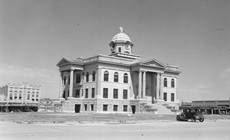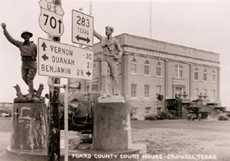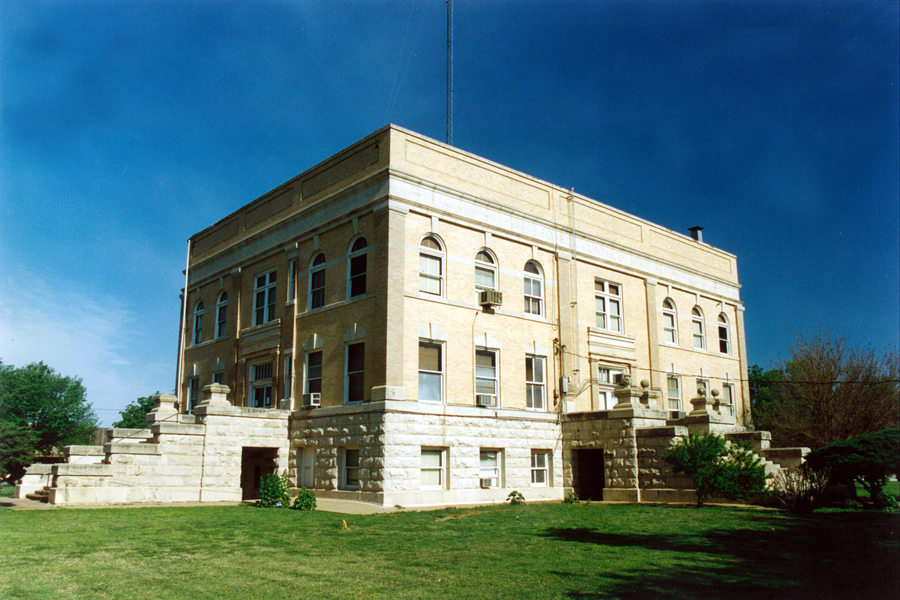Foard County Texas History
FOARD COUNTY. Foard County (A-13), in north central Texas on the rolling plains east of the base of the Panhandle,qv is bounded on the north by Hardeman County, on the west by Cottle County, on the south by Knox County, and on the east by Wilbarger and Baylor Counties. The county's center lies at 33�58' north latitude and 99�45' west longitude. The county, named for Robert L. Foard,qv a lawyer and former Confederate officer, covers an area of 703 square miles ranging from 1,400 to 1,700 feet in altitude. The Wichita River forms part of the southern boundary of the county, and the Pease River forms part of the northern border. Soils vary from deep sand in the east and along the Pease River in the north, to rich loam in the central section, and to rough pasture land in the south and west; the diversity of soils makes possible an unusual diversification in agriculture. The annual rainfall averages 23.93 inches, temperatures range from 28 degrees F average minimum in January to 98 degrees average maximum in July, and the growing season lasts an average of 219 days.
 Foard County Courthouse 1910
Foard County Courthouse 1910


Evidences of prehistoric animals and primitive man have been unearthed in Foard County. In the eighteenth and nineteenth centuries, the abundance of wild fruits and herbs made this area a favorite haunt of Comanche and Kiowa bands, who frequently camped there during the winter as they followed the migrating buffaloqv herds. Pedro Vialqv is thought to have come through the area in 1786. The Comanche chief Peta Noconaqv staged several raids on white settlements from a favorite winter campground on the Pease River near its junction with Mule Creek; he paid the price on December 18, 1860, when Capt. Lawrence S. (Sul) Rossqv and his Texas Rangersqv attacked his camp and captured his wife, the white captive Cynthia Ann Parker,qv and her infant daughter. As Indian power was being broken during the 1870s, hide hunters came into the region on the "Buffalo Road" from Henrietta and points east and killed off the great herds that once roamed the region.
With the Indians and buffalo gone, ranchers began moving their cattle herds into the area that is now Foard County. In 1880, for example, the large Clay County ranch owned by William B. Worshamqv and J. R. Stevens extended its holdings into the area; meanwhile, Dick Forsyth grazed his OX Ranchqv herd on the banks of the Pease River, and J.G. Witherspoon established a ranch. The first post office in the area was established at Pease City in May 1880. Later in the decade the discovery of copper deposits in the northwestern section of the county resulted in attempts to establish a mine there; Gen. George B. McClellanqv led an expedition to the site in 1877. One ore shipment was made, but the venture was abandoned in 1887, mainly because of the lack of water, fuel, and transportation (see COPPER PRODUCTION). By 1890 at least three country schools had been established in the area.
In 1891, Foard County was marked off from lands previously assigned to Cottle, King, Knox, and Hardeman County. Witherspoon had circulated a petition for the county's organization and presented it to the state legislature. Although Beaver County was the original name proposed, the county was named for Robert Foard because he was the law partner of an influential member of the committee that reported on the bill to establish the county. Shortly after the county was authorized on March 3, 1891, the new townsites of Foard City and Crowell vied to become the county seat; a third townsite, Sandrock, was also a contender for a brief time. Crowell was chosen after an election on April 27, 1891. J. C. Roberts was elected county judge, G. W. Thompson county clerk, and S. J. Moore sheriff. Nine school districts were established.
By that time, barbed wire fences had closed the cattle ranges, and farmers had begun to move into the county. In 1900 the United States census counted 1,568 residents in Foard County, which had 210 farms and ranches; according to the agricultural census, cotton cultureqv occupied 1,982 acres in the county, corn cultureqv 2,712 acres, and wheat cultureqv 2,060 acres. Almost 38,000 cattle were counted in Foard County that year. The county's development accelerated after 1908, when the Kansas, Mexico and Orient Railway built tracks from Knox City and Benjamin through Foard County to Chillicothe and established depots at Foard City, Crowell, and Margaret. By 1910, 718 farms and ranches had been established in Foard County, and the county's population had risen to 5,726. More than 21,300 acres in the county was planted in cotton that year, 9,100 acres in corn, and almost 6,700 acres in wheat. Meanwhile, local farmers were also establishing orchards; by 1910 more than 10,000 fruit trees (mostly peach) were cultivated in the county. Cattle ranching continued to be a significant part of the local economy, but since 1900 had declined in importance in both real and relative terms; in 1910, only about 16,000 cattle were counted in the county.
Droughts and other adversities reduced crop production and drove some farmers off their lands in the second decade of the twentieth century; by 1920 the number of farms in Foard County county had dropped to 629, and the population had declined to 4,724. Thanks to an increase in cotton production during the 1920s, the county recovered somewhat during that decade. Cotton acreage expanded to more than 58,500 acres by 1929, and by that year the number of farms in the county had again increased to 720; by 1930 Foard County had a population of 6,315.
Agriculture suffered serious setbacks during the 1930s, however, because of the Great Depressionqv and the concurrent Dust Bowl.qv Cotton production plunged by more than 50 percent, and by 1940 only 24,098 acres of Foard county was planted in the fiber; wheat production also dropped from about 33,400 acres in 1929 to about 24,100 acres in 1940. More than 15 percent of the county's farmers were forced out of business during this period, and by 1940 only 561 farms remained. County population also dropped by more than 15 per cent during the 1930s; by 1940, 5,237 people were left. The thirties would have been even more difficult for the county, but oil production helped to reduce some of the depression's worst effects.
Although oil leases in Foard County had been sold as early as 1901, no actual discoveries were made until 1925, when the Thalia field was first drilled; the boom there started in 1929, when the Shell Petroleum Company struck a pool that yielded 500 barrels a day. Beginning in 1933 the Texas Company (Texacoqv) discovered the county's largest oil and gas field twenty miles west of Crowell. In March 1934 a $150,000 natural gas stripping plant was built at the field, with a three-inch pipeline laid from there to the railroad tracks at Foard City. Another pipeline was built to transport natural gas about thirty miles to the West Texas Utilities plant east of Quanah. The Gamble-Dickerson field northeast of Crowell produced several wells beginning in 1940, but gas pressure and shallow oil depths later led to its abandonment. In 1938 county oil production reached 240,742 barrels, but by 1944 production had declined to 59,408 barrels; by 1948 it had dropped to 22,012 barrels, and by 1956 only 769 barrels of petroleum were produced in the county. A resurgence occurred in the late 1950s, when the Lucerne Corporation opened the Rasberry field nine miles northwest of Crowell. In 1960 the county produced 850,330 barrels of crude; in 1978, almost 191,000 barrels; and in 1982, 493,234 barrels. In 1990 production was more than 347,000 barrels. Cumulatively, by the beginning of 1991, 20,816,157 barrels of crude had been produced in Foard County since 1929.
After the 1940s the mechanization of agriculture combined with other factors, such as the severe droughts of the 1950s, to depopulate the area steadily. The county's population dropped to 4,216 in 1950, 3,125 in 1960, 2,211 in 1970, and 2,158 in 1980. In 1992, an estimated 1,794 people lived in Foard County. The shrinking population has remained generally loyal to the Democratic party.qv In presidential elections from 1952 to 1988 the county voted only twice for Republican candidates: in 1972 for Richard Nixon, and in 1984 for Ronald Reagan. Even in those years, the county supported Democratic candidates in gubernatorial and senatorial elections.
Alongside oil and cattle, agriculture has remained a leading industry of Foard County, of which more than 4,000 acres are irrigated. Cotton, wheat, and other grains are the chief crops, while irrigationqv and subirrigation, beginning in the 1940s, made possible the limited commercial production of fruits and vegetables, especially onions and sweet potatoes, in the eastern part of the county. Poultry and other livestock also add to the area's farm income, which averaged $11.5 million annually during the 1980s. The county's gins handled some 4,000 bales of cotton during harvest, while its grain elevators contained more than 350,000 bushels. According to the United States agricultural census for 1982, Foard County produced 1,162,749 bushels of wheat, 14,623 bushels of sorghum, and 7,748 bales of cotton that year; 14,771 cattle were also reported. In the 1980s the county had one bank with assets of nearly $21 million.
U.S. Highway 70 intersects State Highway 6 at Crowell, and several farm and ranch roads provide access to outlying communities. Crowell (1992 estimated population: 1,230) is the county's largest town and the county seat. Although the town was devastated by a tornado on April 27, 1942, it recovered quickly and remains the center of the county's agribusiness and oil economy; Foard County's sole newspaper, the Foard County News, is published in the town. Other communities include Margaret, Vivian, Foard City, and Rayland.
BIBLIOGRAPHY: Bailey Phelps, They Loved the Land: Foard County History (Quanah, Texas: Quanah Tribune-Chief, 1969).
John Leffler